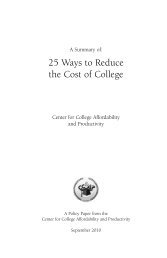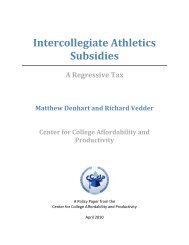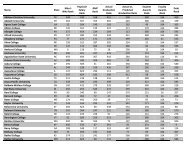Twelve Inconvenient Truths About Higher Education - The Center for ...
Twelve Inconvenient Truths About Higher Education - The Center for ...
Twelve Inconvenient Truths About Higher Education - The Center for ...
Create successful ePaper yourself
Turn your PDF publications into a flip-book with our unique Google optimized e-Paper software.
TWELVE INCONVENIENT TRUTHS ABOUT HIGHER EDUCATION<br />
FIGURE 5: NON-FACULTY PROFESSIONAL EMPLOYEES PER 100 FACULTY<br />
120<br />
100<br />
80<br />
85.8<br />
97.3<br />
60<br />
40<br />
52.4<br />
20<br />
0<br />
1976 1999 2009<br />
Source: U.S. Department of <strong>Education</strong>, National <strong>Center</strong> <strong>for</strong> <strong>Education</strong> Statistics, author calculations<br />
University presidents succeed by raising bushels of money which are distributed, almost like bribes, to<br />
various constituent groups to make them happy—faculty members by giving them good salaries, low<br />
teaching loads and good parking; administrators by giving them high salaries and lots of assistants to do<br />
the real work; alumni by having good athletic teams playing in fancy facilities; and students by having<br />
easy grading, little demanding coursework, and access to lots of booze and sex.<br />
<strong>Inconvenient</strong> Truth #11:<br />
Federal Student Financial Aid Doesn’t Work<br />
Federal student financial assistance programs began to either help economically disadvantaged students<br />
or to promote study of certain fields, such as math and science after the Soviet Union’s launching<br />
of Sputnik in October 1957. <strong>The</strong> evidence is they have really done little in achieving either of these<br />
objectives, but probably have contributed measurably to the rise in college costs. Moreover, the programs<br />
are Byzantine in their complexity, and the mere application <strong>for</strong> assistance until very recently has involved<br />
completing a <strong>for</strong>m of over 100 questions that scared off many potential low income students.<br />
Moreover, the programs provide perverse incentives. A poor student receiving Pell Grants who hangs out<br />
around college <strong>for</strong> six years gets perhaps twice as much money as an otherwise identical student who is at<br />
the top of her class and, by going to summer school and working hard, graduates in three years. Students<br />
who have little probability of succeeding in college are treated the same as those whose previous records<br />
indicates a high likelihood of success. Academic distinction or excellence is ignored and even punished.<br />
Not only is academic per<strong>for</strong>mance ignored, but so is any sort of consideration of risk of loan default.<br />
12







